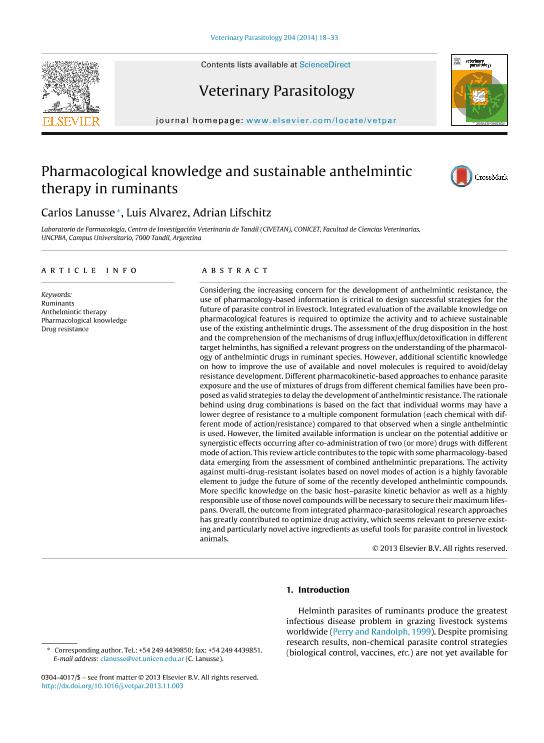Mostrar el registro sencillo del ítem
dc.contributor.author
Lanusse, Carlos Edmundo

dc.contributor.author
Alvarez, Luis Ignacio

dc.contributor.author
Lifschitz, Adrian Luis

dc.date.available
2018-01-16T21:35:04Z
dc.date.issued
2013-11
dc.identifier.citation
Alvarez, Luis Ignacio; Lifschitz, Adrian Luis; Lanusse, Carlos Edmundo; Pharmacological knowledge and sustainable anthelmintic therapy in ruminants; Elsevier Science; Veterinary Parasitology; 204; 1-2; 11-2013; 18-33
dc.identifier.issn
0304-4017
dc.identifier.uri
http://hdl.handle.net/11336/33550
dc.description.abstract
Considering the increasing concern for the development of anthelmintic resistance, the use of pharmacology-based information is critical to design successful strategies for the future of parasite control in livestock. Integrated evaluation of the available knowledge on pharmacological features is required to optimize the activity and to achieve sustainable use of the existing anthelmintic drugs. The assessment of the drug disposition in the host and the comprehension of the mechanisms of drug influx/efflux/detoxification in different target helminths, has signified a relevant progress on the understanding of the pharmacology of anthelmintic drugs in ruminant species. However, additional scientific knowledge on how to improve the use of available and novel molecules is required to avoid/delay resistance development. Different pharmacokinetic-based approaches to enhance parasite exposure and the use of mixtures of drugs from different chemical families have been proposed as valid strategies to delay the development of anthelmintic resistance. The rationale behind using drug combinations is based on the fact that individual worms may have a lower degree of resistance to a multiple component formulation (each chemical with different mode of action/resistance) compared to that observed when a single anthelmintic is used. However, the limited available information is unclear on the potential additive or synergistic effects occurring after co-administration of two (or more) drugs with different mode of action. This review article contributes to the topic with some pharmacology-based data emerging from the assessment of combined anthelmintic preparations. The activity against multi-drug-resistant isolates based on novel modes of action is a highly favorable element to judge the future of some of the recently developed anthelmintic compounds. More specific knowledge on the basic host–parasite kinetic behavior as well as a highly responsible use of those novel compounds will be necessary to secure their maximum lifespans. Overall, the outcome from integrated pharmaco-parasitological research approaches has greatly contributed to optimize drug activity, which seems relevant to preserve existing and particularly novel active ingredients as useful tools for parasite control in livestock animals.
dc.format
application/pdf
dc.language.iso
eng
dc.publisher
Elsevier Science

dc.rights
info:eu-repo/semantics/openAccess
dc.rights.uri
https://creativecommons.org/licenses/by-nc-nd/2.5/ar/
dc.subject
Sustained Control
dc.subject
Resistance
dc.subject
Ruminants
dc.subject.classification
Otras Ciencias Veterinarias

dc.subject.classification
Ciencias Veterinarias

dc.subject.classification
CIENCIAS AGRÍCOLAS

dc.title
Pharmacological knowledge and sustainable anthelmintic therapy in ruminants
dc.type
info:eu-repo/semantics/article
dc.type
info:ar-repo/semantics/artículo
dc.type
info:eu-repo/semantics/publishedVersion
dc.date.updated
2018-01-16T18:47:38Z
dc.journal.volume
204
dc.journal.number
1-2
dc.journal.pagination
18-33
dc.journal.pais
Países Bajos

dc.journal.ciudad
Amsterdam
dc.description.fil
Fil: Lanusse, Carlos Edmundo. Consejo Nacional de Investigaciones Científicas y Técnicas. Centro Científico Tecnológico Conicet - Tandil. Centro de Investigación Veterinaria de Tandil. Universidad Nacional del Centro de la Provincia de Buenos Aires. Centro de Investigación Veterinaria de Tandil. Provincia de Buenos Aires. Gobernación. Comision de Investigaciones Científicas. Centro de Investigación Veterinaria de Tandil; Argentina
dc.description.fil
Fil: Alvarez, Luis Ignacio. Consejo Nacional de Investigaciones Científicas y Técnicas. Centro Científico Tecnológico Conicet - Tandil. Centro de Investigación Veterinaria de Tandil. Universidad Nacional del Centro de la Provincia de Buenos Aires. Centro de Investigación Veterinaria de Tandil. Provincia de Buenos Aires. Gobernación. Comision de Investigaciones Científicas. Centro de Investigación Veterinaria de Tandil; Argentina
dc.description.fil
Fil: Lifschitz, Adrian Luis. Consejo Nacional de Investigaciones Científicas y Técnicas. Centro Científico Tecnológico Conicet - Tandil. Centro de Investigación Veterinaria de Tandil. Universidad Nacional del Centro de la Provincia de Buenos Aires. Centro de Investigación Veterinaria de Tandil. Provincia de Buenos Aires. Gobernación. Comision de Investigaciones Científicas. Centro de Investigación Veterinaria de Tandil; Argentina
dc.journal.title
Veterinary Parasitology

dc.relation.alternativeid
info:eu-repo/semantics/altIdentifier/doi/http://dx.doi.org/10.1016/j.vetpar.2013.11.003
dc.relation.alternativeid
info:eu-repo/semantics/altIdentifier/url/http://www.sciencedirect.com/science/article/pii/S0304401713005943
Archivos asociados
